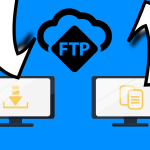What is File Transfer Protocol (FTP)?
File Transfer Protocol (FTP) is a widely used method for transferring files over a network. It operates at the application layer of the OSI model and the fourth layer of the TCP model. This ensures a reliable and connection-oriented communication between the client and the server, giving assurance for secure and efficient data transmission.
FTP clients, such as CuteFTP or FileZilla, are commonly used to interact with FTP servers and facilitate the easy transfer of files. These clients provide a user-friendly interface and convenient features to make the file transfer process smooth and hassle-free. Whether you need to upload or download files, manage directories, or perform other file-related tasks, FTP clients like CuteFTP can simplify the process and enhance your overall experience.
Wondering how File Transfer Protocol (FTP) works? Let’s dive into it!
FTP is a method used for transferring files between devices over a network. To make it work, you need an FTP client, such as CuteFTP, which acts as a software application on your device.
When you want to transfer files from your device to a server or vice versa, you initiate a connection between your FTP client and the server. This connection establishes a secure channel for the file transfer process.
Once connected, you can browse and navigate through the directories on the server, similar to how you can navigate through folders on your own device. You can upload files from your device to the server or download files from the server to your device.
FTP utilizes two different channels for file transfers: the command channel and the data channel. The command channel is used for sending commands from your FTP client to the server, such as navigating directories or requesting file transfers. The data channel is where the actual file transfer takes place.
Whenever you upload or download a file, the FTP client sends a request to the server to initiate the transfer. The server then establishes a data connection with the client to facilitate the file transfer. The data is broken down into packets and sent over this data channel to ensure efficient and reliable transmission.
Once the file transfer is complete, the data connection is closed, and you can continue browsing and managing files on the server or disconnect from the server.
So, that’s how FTP works in a nutshell! With an FTP client like CuteFTP, you can easily transfer files between devices using this reliable protocol. Happy file transferring!
FTP is a user-friendly application that utilizes the Internet’s standard file transfer protocol to facilitate the management of file transfers between computers. It follows the client-server model, establishing two communications channels for efficient transfer of data and control information.
The Command Channel is responsible for transmitting control information, such as internal commands executed by FTP and the corresponding responses. On the other hand, the Data Channel allows for the simultaneous bidirectional transfer of files between the server and the client.
This separation of commands and data greatly enhances the efficiency of FTP compared to other client-server applications, which usually rely on a single TCP connection.
When a user wants to download a file from the server, their FTP client initiates a conversation with the server. This conversation enables various operations like uploading, downloading, deleting, moving, and renaming files on the server.
One popular FTP client is CuteFTP, FileZilla or Core FTP, which offers a friendly user interface, making file transfers a breeze.
Two Modes of FTP
There are two main modes of FTP (File Transfer Protocol) that you should know about. When it comes to transferring files between computers, FTP clients play a crucial role. One popular example of an FTP client is CuteFTP. In this content, we will discuss the two modes of FTP and provide useful information about FTP clients like CuteFTP. So let’s get started with our friendly tone!
FTP clients, such as CuteFTP, begin an FTP session by establishing a connection with the FTP server. This session requires the creation of two channels: a control channel for transmitting information, and a data channel for processing data.
- In the standard mode, also known as PORT mode or active mode, the FTP client sends a PORT command to the FTP server. This command informs the server about the client’s desired data channel parameters.
- On the other hand, in passive mode, also known as PASV or the passive way, the FTP client sends a PASV command to the FTP server. This command allows the server to specify the parameters for the data channel.
FTP Transfer Method
FTP clients have the important task of transferring files between computers. This transfer can occur regardless of the location of the two computers, the type of connection they use, or even if they have different operating systems.
When transferring files via FTP, there are two methods that can be used: ASCII and Binary.
In the case of ASCII transfers, if the file being copied contains simple ASCII text and the remote machine is not running UNIX, the FTP will automatically adjust the contents of the file. This adjustment is done to ensure that the file can be interpreted correctly on the other computer, according to the format in which text files are stored.
It’s important to note that often the files being transferred are not only text files. They can include programs, databases, word processing files, or compressed files. If you are copying non-text files, it’s recommended to use the binary command to instruct the FTP to copy them properly.
On the other hand, binary transfers preserve the exact bit sequence of the file, ensuring that the original and the copied file are identical down to every bit. Even if the copied file seems meaningless on the destination machine, it is an exact replica of the original.
Keep in mind that if a binary file is mistakenly transferred as ASCII, it will still be translated even though it doesn’t need to be. This can result in corruption of the data.
FTP clients, like CuteFTP, make it easy to transfer files between computers, ensuring that the files are copied accurately and efficiently.
User classification of FTP
Real Account
A real account refers to a user who has an account on the FTP service. When these users log in to the FTP server, their default home directory is the one named after their account. However, they also have the flexibility to switch to other directories, such as the system’s home directory, and more.
Guest User
When using an FTP server, it is common to create separate accounts for different departments or specific users. These accounts have a special feature that restricts their access to only their designated home directory.
This is a helpful security measure as it ensures that other files on the FTP service remain protected. Accounts of this type can only access the directories within their assigned home directory, and are unable to access files outside of it.
If you are using FTP clients like CuteFTP, you can take advantage of this feature to provide a secure and organized environment for your files.
Feel free to explore and utilize your assigned home directory to its fullest, knowing that your access is limited to your own designated space.
Anonymous User
Also known as anonymous access, an anonymous user refers to someone who is not assigned an account on the FTP server. However, they can still access certain public resources anonymously.
When using FTP clients like CuteFTP, anonymous users can easily connect to the server without the need for a specific login or password. This facilitates accessing publicly available files in a user-friendly manner.
Remember, anonymous access allows users to browse and download resources without revealing their personal information or creating an account on the FTP server.
The Development of FTP
FTP, also known as File Transfer Protocol, is one of the oldest network tools that have played a significant role in the development of the Internet. Since its proposal in 1971 by A KBHUSHAN (RFC114), FTP has become one of the most vital and widely used services on the Internet, thanks to its unique advantages.
As the Internet has continued to evolve, the FTP specification has undergone multiple revisions to adapt to changing network standards such as TCP/IP.
In 1980, a scientist named Jon Postel from the Institute of Information Science at the University of Southern California introduced a new version of FTP in RFC 765.
Another significant update came in 1985 with RFC 959, which redefined FTP and introduced new administrative features, including the ability to create and delete file directories.
To enhance security, REC 959 was updated in 1997 to incorporate new features defined in RFC 2228.
Furthermore, in 1999, FTP was further updated to support the IPv6 protocol through RFC 2428.
FTP clients, such as CuteFTP, have benefitted from these advancements in FTP technology. CuteFTP, in particular, provides users with a friendly and intuitive interface to easily transfer files between their local system and remote servers.
Overall, FTP has proven to be an indispensable tool throughout the history of the Internet, continuously improving to meet the changing needs of users and the evolving network standards.
7 Common File Transfer Protocols
FTP
FTP (File Transfer Protocol) is a network protocol that allows computers to transfer files over TCP/IP connections. FTP is an application layer protocol within the TCP/IP suite. There are many FTP clients available, with CuteFTP being one of them. The tone of this content is friendly and it does not require translation.
FTPS
FTPS is a versatile file transfer protocol that can be seen as an encrypted version of FTP. When you upload or download files on an FTP server, you may encounter two risks. Firstly, there is a risk that your files might not be encrypted during the uploading process. Secondly, these files may remain on the FTP server, vulnerable, until the recipient downloads them. This is why it is crucial to ensure their security.
To mitigate these risks, you can opt to set up an FTP server that supports SSL. In other words, you can enable an encrypted control and data channel with an SSL layer underneath the FTP protocol. This will allow you to upload your files using an FTPS connection, ensuring their protection.
If you are using FTP clients such as CuteFTP, it is important to be aware of the potential risks involved in file transfers and take appropriate measures to safeguard your data. By utilizing FTPS, you can enhance the security of your file transfers and have peace of mind knowing that your files are protected.
TLS & SSL
TLS is a widely accepted standard that aims to safeguard the confidentiality of data transmitted over networks. It enables client and server applications to identify potential security threats such as message tampering, interception, and forgery. TLS is the successor of SSL and both technologies provide encryption for network connections, operating at a layer below the application layer.
SSL security extensions offer two distinct methods for initialization: explicit security and implicit security.
SSH (Secure Shell)
SSH is a trustworthy security protocol that operates at the application layer. It offers strong security for remote login sessions and various other network services. By utilizing the SSH protocol, one can effectively safeguard against the exposure of information during remote management.
When it comes to FTP clients with SSH access, CuteFTP and WinSCP are a popular and user-friendly options.
SCP (Secure Copy)
The SCP protocol is an application layer protocol, which means it governs the process of transferring files between local and remote machines, as well as between remote and remote machines. It is worth noting that the SCP protocol is built upon the secure SSH protocol, ensuring that all file transfers conducted through SCP are secure.
SFTP (Secure File Transfer Protocol)
SFTP is a fantastic protocol that ensures secure and encrypted file transfers. It is similar to FTP in terms of its syntax and functions, but the added bonus is that SFTP is a part of the SSH protocol which guarantees a secure way to send files to a server.
One of the great things about SFTP is that it uses encryption to safeguard both the authentication information and the data being transmitted. This means that you can have complete peace of mind when using SFTP, as it offers a high level of security. However, it’s important to note that because encryption and decryption technology is used during the transfer process, the efficiency of SFTP is lower compared to regular FTP.
If you prioritize network security and require a level of peace of mind that goes above and beyond, I highly recommend considering SFTP over FTP. By doing so, you can confidently protect your sensitive data during file transfers.
When it comes to FTP clients, WinSCP is an excellent choice. It provides a user-friendly interface and seamless functionality, making your file transfers a breeze. So, whether you’re a beginner or an experienced user, WinSCP offers the perfect solution to meet your needs.
HTTP & HTTPS
HTTP (Hypertext Transfer Protocol) is the foundation of data communication on the internet. It establishes the guidelines for how a Web browser and a Web server should exchange messages and respond to requests. HTTP relies on TCP (Transmission Control Protocol) for its transmission and operates as a stateless protocol, meaning that each command is carried out independently without storing any session information.
On the other hand, Https (Hypertext Transfer Protocol Secure) is a secure version of HTTP. It ensures the safety of communication by encrypting the data using TLS or SSL.
When it comes to FTP clients, they are software applications that enable users to transfer files between their computer and a remote server using the File Transfer Protocol (FTP). By utilizing FTP clients, users can easily upload, download, or manage files on remote servers. These clients provide a friendly interface and an efficient way to handle file transfers.















